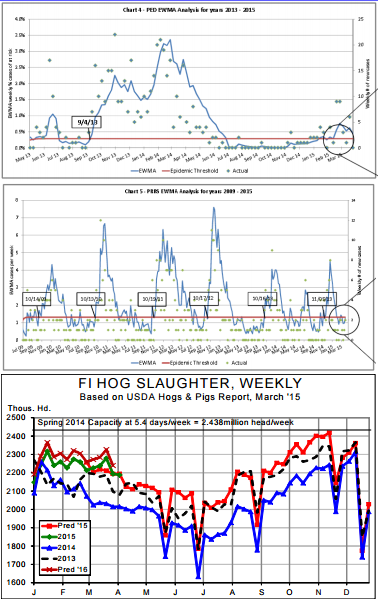



CME: PEDv Piglet Losses Down This Year
US - Larger hog slaughters have provided ample evidence that piglet death losses have been substantially lower this year, write Steve Meyer and Len Steiner.But we haven’t had a PEDv update in some time so we thought that would be appropriate today, especially in light of yesterday’s huge reported FI hog slaughter of 452,000 head. If that was a one?day total, it would be the largest ever. But USDA noted that it included some Sunday slaughter and USDA revised last week’s numbers down 16,000 — 11,000 for Friday and 6,000 for Saturday.
We suspect that a plant shifted some operations from one of or both of those days to Sunday and that somewhere between 10,000 and 16,000 head of yesterday’s reported 452,000 occurred on Sunday. That would still leave Monday slaughter near 440,000 head.
Only five other times in history have we slaughtered that many hogs and four of them were in December and one was in November. To say the least, April is an odd time to see numbers like this.
There are obviously two drivers: Expansion and survival. The expansion was documented in the December (+3.7 per cent on the breeding herd) and March (+2.2 per cent ). Are those numbers large enough?
Some are arguing they are not but they are the numbers for now. Piglet survival has been remarkable this year relative to one year ago and the improvement is not just because of PEDv. It is due to a sharp increase in the general health status of the US herd. PEDv is the leading factor due to its huge impact one year ago. But the top chart demonstrates that the frequency of PEDv on sow farms owned by companies surveyed by the University of Minnesota is sharply lower than one year ago with the worst weeks this year seeing only nine sow farms break with PEDv.
Anecdotal evidence (ie. not from the UM survey or reports) indicate that piglet death losses were much lower on most sow farms that did break this year. USDA’s Dec-Feb pigs saved per litter figure of 10.17 is 6.7 per cent higher than one year ago - exactly the percentage higher that we predicted if piglet losses would by some miracle fall to pre-PEDv normal. We aren’t saying they were in fact to that low during the quarter but they were close.
The other factor of piglet survival is a second year of very low incidence of porcine respiratory and reproductive syndrome virus (PRRSv). This disease has been a plague for several years primarily because it mutates so readily and there is limited cross immunity between the serotypes.
Last year’s significant reduction in PRRSv frequency was attributed largely to Draconian biosecurity measure taken to fight PEDv. This year’s low PRRSv figures support that conclusion.
There is one caveat: North Carolina has been dealing with a highly virulent PRRSv strain since February. North Carolina operations are not represented much (if at all) in the UM PRRSv sample so these cases do not show up in the second chart. The sum impact, of course, is much higher pig numbers as evidenced in the bottom chart.
Thus far, actual slaughter ahs been just 0.9 per cent higher than the levels predicted by the March report. It is good to finally get something close to what we expect - but that suggests much larger slaughter numbers through Q3. Q4 is at present an enigma. Lower farrowing intentions and a smaller year-on-year increase in litter size point to Jun-Aug pig crop equal to 2014.
That would mean Dec?Feb 2016 supplies could be much like this year - good news for December and PLENTY SCARY FOR 2016. The past five years have seen Q4 weekly slaughter totals run roughly 150,000 higher than those of Q1. Based on our Predicted ‘16 weekly numbers for Q1, that would put Q4 weekly runs at 2.45 million. The 2.438 million capacity is NOT A HARD A FAST NUMBER but several weeks at or above it will put heavy pressure on product prices due to supplies and may exacerbate that pressure at the hog level due to capacity issues.









